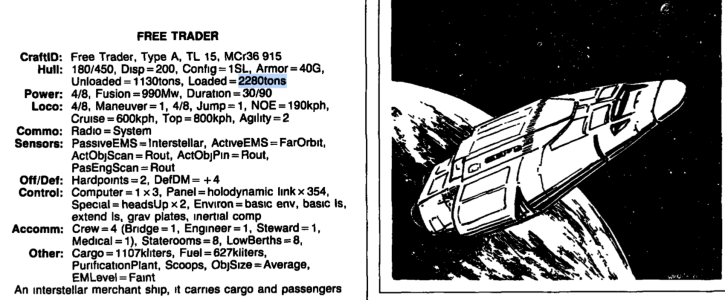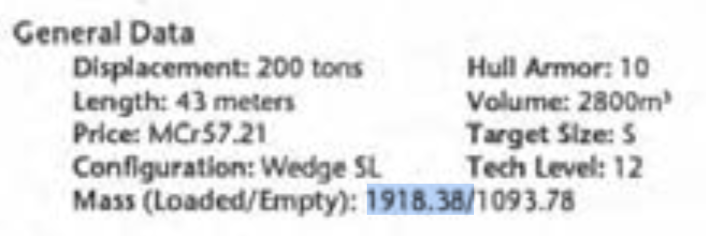Badenov
SOC-13
So, something that has been bothering me for a while are dTons. I think they're handled differently in different versions, which makes the issue more confusing, but I will talk to Mongoose 2008, the version I own. Simple version is this, as I understand it (heavy emphasis here, I have been known to misunderstand things): A ship is rated in dtons, the tons of liquid hydrogen that the volume of the ship displaces. Or could contain. There seems to be some confusion, at least on my part, and the result is a paper-thin membrane of hull, with no mass or thickness. Now since armor takes volume, it can be your hull volume, that makes sense at least. If you have a 100dTon hull, with 10dTons of armor, the interior has 90dTons. I am OK so far.
The game seems to lean into physics when it can, so it makes sense to me that the amount of acceleration a ship can develop is a balance between it's mass, regardless of volume (outside an atmosphere, anyhow), and the amount of thrust it's rated for, given helpfully in G's by the engine designers. I had assumed Jumping would be the same, though the existence of drop tanks makes that not the case. So maybe jumping is based on volume rather than mass? It's space magic, either way, but I get confused if Thrust is based on mass and Jump is based on volume.
Now the cargo capacity of the ship is also rated in dTons, which makes sense since it's straight arithmetic and minimizes calculations, but leads to some cases which seem odd to me. If your cargo is liquid hydrogen, of course, your hold is full to the top. But 1 dton of water, by mass, is about a cubic meter, or 1/14 of the space of a dTon. So if you're carrying water as cargo, you can only have your hold 1/14 full, by volume, or you'd be over mass and your thrust 1 engine would now be a thrust 0 engine. You could still Jump, if Jump is based on volume, but you'd never make it to the 100-diameter limit without a tow.
Now as to what you have in your cargo hold, steel is 7.8 times as dense as water, which being 14 times denser than liquid hydrogen, makes steel 109 times as dense as liquid hydrogen. So if cargo is rated by the mass side of dTonnage, a 1 dTon load of steel is 1000kg of steel, which is a very thin, like 1cm thin, layer on the deck. If cargo is rated by the volume side of dTonnage, it fills the entire space, but weighs 109,000kg/109 metric tons.
I am confused because neither case makes much sense to me. The game I'm in uses the first way, and just ignores the silly of tiny patches of cargo on mostly clear deck. Is there some guidance in other Traveller versions? I could see a spur of TL9 grav thruster development being ineria-less cargo bays limited by volume without impacting mass. If done to a fuel tank also, that would make thrust the same whether the tank is empty or full, which seems to be how vessels are assumed to be, though generally most ships thrust are rated for a full fuel tank, and I'm not clear on why when you'd have more thrust at 2/3 your fueled mass and if you're nullifying the mass of the tank.... it all gets twisty and confused when you're doing science babble. Maybe the mass nullifiers have a bleedover effect, such that everything has the effective mass of liquid hydrogen, but that would make firearms and other projectile weapons useless as the bullets/needles/whatever would have no mass behind them.
I have a harder time leaning into M-drive being not only reactionless but totally unaffected by mass and going by volume also. But I'm wildly at a loss when trying to reconcile these issues. Any advice is welcome.
The game seems to lean into physics when it can, so it makes sense to me that the amount of acceleration a ship can develop is a balance between it's mass, regardless of volume (outside an atmosphere, anyhow), and the amount of thrust it's rated for, given helpfully in G's by the engine designers. I had assumed Jumping would be the same, though the existence of drop tanks makes that not the case. So maybe jumping is based on volume rather than mass? It's space magic, either way, but I get confused if Thrust is based on mass and Jump is based on volume.
Now the cargo capacity of the ship is also rated in dTons, which makes sense since it's straight arithmetic and minimizes calculations, but leads to some cases which seem odd to me. If your cargo is liquid hydrogen, of course, your hold is full to the top. But 1 dton of water, by mass, is about a cubic meter, or 1/14 of the space of a dTon. So if you're carrying water as cargo, you can only have your hold 1/14 full, by volume, or you'd be over mass and your thrust 1 engine would now be a thrust 0 engine. You could still Jump, if Jump is based on volume, but you'd never make it to the 100-diameter limit without a tow.
Now as to what you have in your cargo hold, steel is 7.8 times as dense as water, which being 14 times denser than liquid hydrogen, makes steel 109 times as dense as liquid hydrogen. So if cargo is rated by the mass side of dTonnage, a 1 dTon load of steel is 1000kg of steel, which is a very thin, like 1cm thin, layer on the deck. If cargo is rated by the volume side of dTonnage, it fills the entire space, but weighs 109,000kg/109 metric tons.
I am confused because neither case makes much sense to me. The game I'm in uses the first way, and just ignores the silly of tiny patches of cargo on mostly clear deck. Is there some guidance in other Traveller versions? I could see a spur of TL9 grav thruster development being ineria-less cargo bays limited by volume without impacting mass. If done to a fuel tank also, that would make thrust the same whether the tank is empty or full, which seems to be how vessels are assumed to be, though generally most ships thrust are rated for a full fuel tank, and I'm not clear on why when you'd have more thrust at 2/3 your fueled mass and if you're nullifying the mass of the tank.... it all gets twisty and confused when you're doing science babble. Maybe the mass nullifiers have a bleedover effect, such that everything has the effective mass of liquid hydrogen, but that would make firearms and other projectile weapons useless as the bullets/needles/whatever would have no mass behind them.
I have a harder time leaning into M-drive being not only reactionless but totally unaffected by mass and going by volume also. But I'm wildly at a loss when trying to reconcile these issues. Any advice is welcome.


